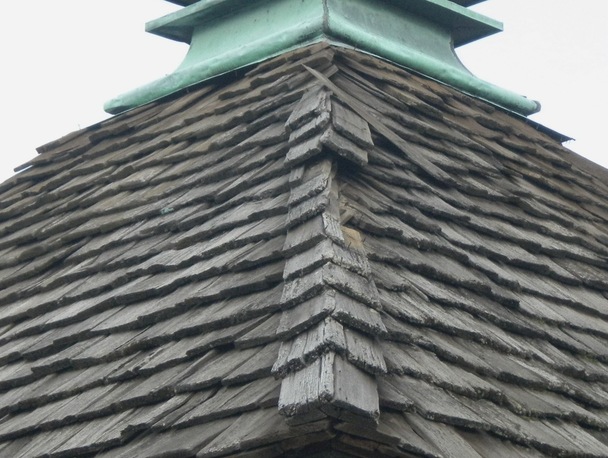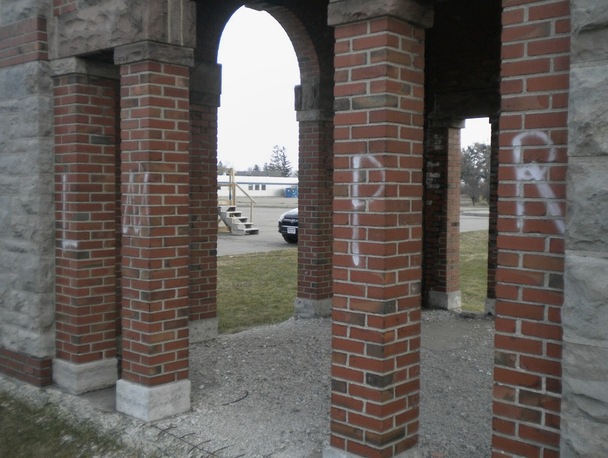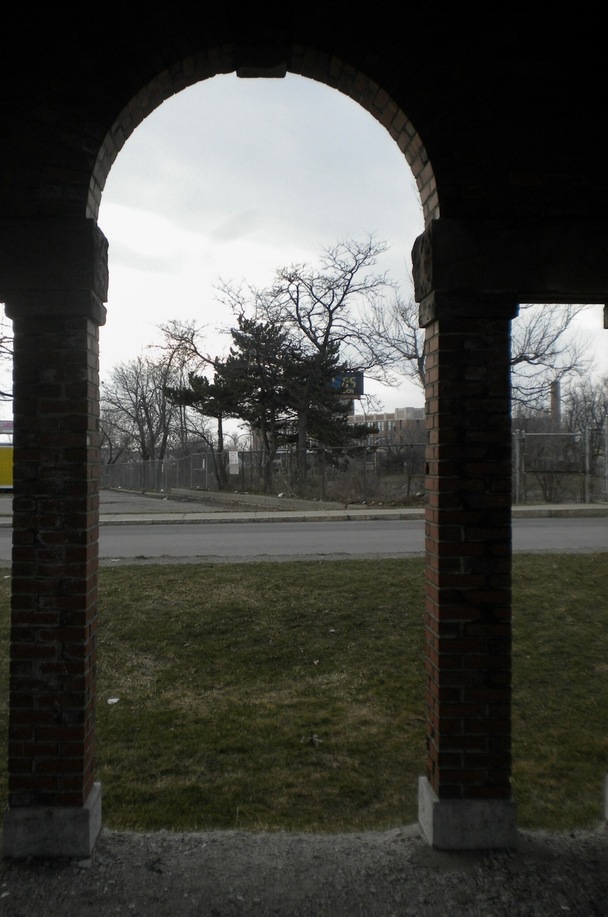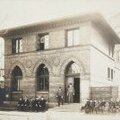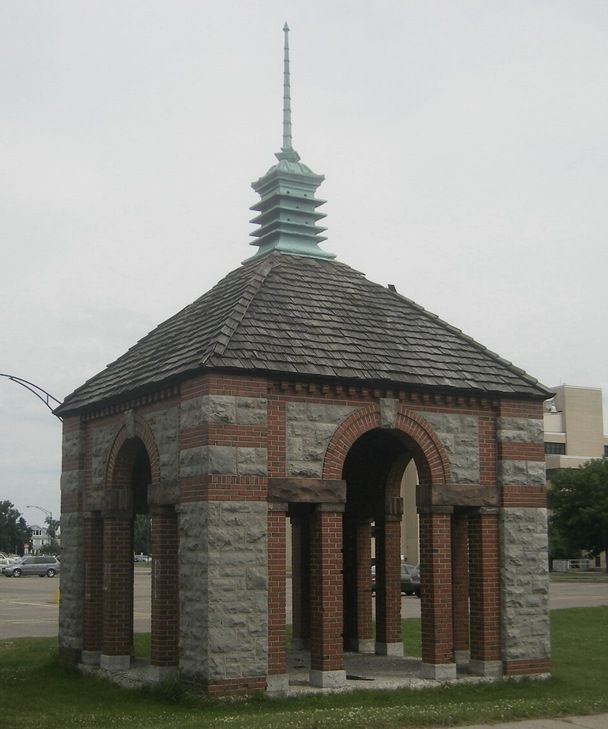
The gazebo, whose origins are unknown, stands with Erie County Medical Center in the background.
Photo by Dean Gowen
Driving along the Kensington Expressway towards downtown Buffalo, there is a slightly visible gazebo overlooking the road from the Erie County Medical Center campus just before the Scajaquada Expressway interchange. Innocuous at first sight, with the cedar-shingle roof and concrete foundation showing signs of decay, a closer look reveals a well-designed structure that baffles many a modern observer as to its original purpose. Sturdily built of brick, limestone and sandstone, the building’s highlight is the copper cupola adorning the roof, which has caught the eye of many a curious passerby.
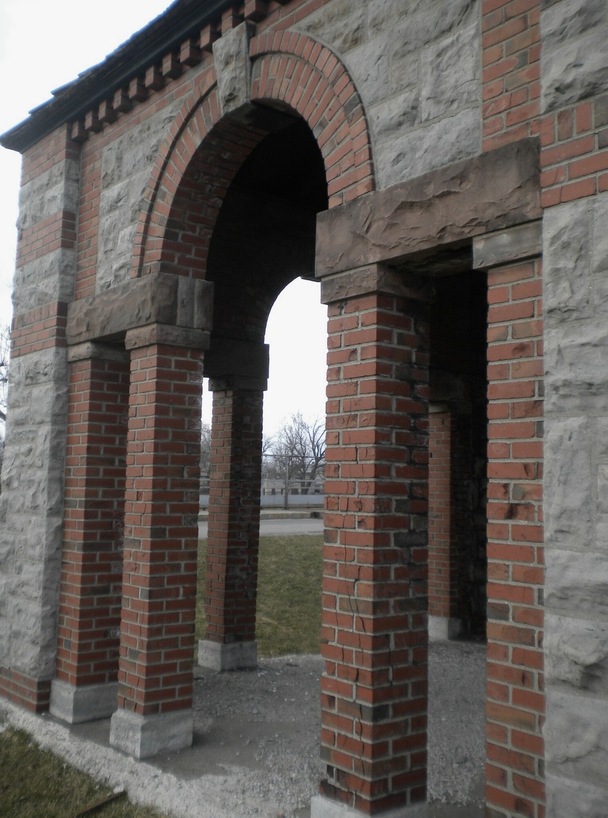
The brick, sandstone and limestone used to construct the building create a solid design.
Photo by Dean Gowen
The gazebo is surrounded by ECMC parking lots, sitting on a service road connecting Kensington Avenue on the north side of Route 33 and the ECMC lots on the south side. Google Maps offers a virtual look at the building, showing the lonely gazebo in a sea of concrete. At Western New York Heritage, staff members and subscribers alike have often inquired as to the reason for this pavilion’s existence. For such a small and isolated structure, it is well built with stone and brick, and beautifully capped with a birdhouse-like cupola, the most visible feature of the gazebo.
About ECMC
The origins of ECMC date back more than a century to the Municipal Hospital, built on East Ferry Street in 1905. As demand grew, the new Buffalo City Hospital was built at 462 Grider St. around 1912. In 1939, the facility was renamed for hospital co-founder Dr. Edward J. Meyer, who served the people of Buffalo from 1912 into the 1930s. Meyer helped develop the hospital into one of the leading teaching facilities of its time. During the early-1970s a modern hospital was built and renamed ECMC.
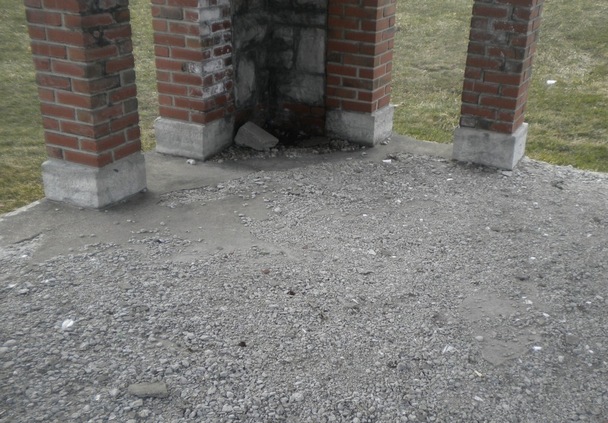
Though the cement foundation shows decay, preservationists believe it could still be moved if that were determined to be the best course of action.
Photo by Dean Gowen
What is it?
Thanks to the efforts of Dean Gowen, Chuck LaChiusa, Mike Schalk and a post on Buffalo Rising, some details of the gazebo’s history have been uncovered. But as is often the case with history, we have a better idea of what it is not, rather than what it is.
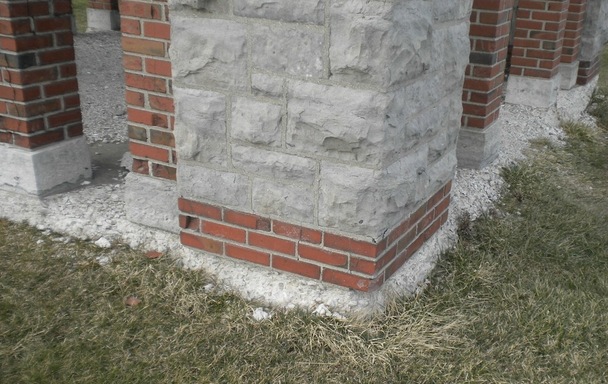
While the brick is starting to show its age, the gazebo is in remarkably good shape despite the lack of attention it received over the last 30-plus years.
Photo by Dean Gowen
Although the architecture style seems to date it to the late 1920s or early 1930s, the 1927 Erie County aerial survey does not show the buildings. Schalk previously interviewed his late grandmother who grew up in the neighborhood from 1908 to 1913, the late Al Kerr who grew up there in the 1920s and the late Sister Marie Anthony Van Dick who also grew up there in the 1920s, and none could recall the structures. A postcard of the Meyer Hospital grounds, apparently from the 1930s, also shows well-kept grounds but no gazebos.
Schalk found the gazebo on a 1951 aerial photo-map of Buffalo, which suggested the structure was once used as a gatehouse for the hospital. Posts on Buffalo Rising seem to confirm its usage as a gatehouse.
According to Schalk, by the mid-1960s grass and brush had begun to overgrow the four buildings, with the largest one, located in the center of the complex, showing roof deterioration. He states that the buildings were still standing in 1971 as the new ECMC was developed, and they were torn down in the late 1970s to make way for the final design of the medical campus. The three buildings closer to the new facility were lost forever, but our subject gazebo, possibly protected by its remote location at the edge of a parking lot, was saved from the proverbial wrecking ball.
The Gazebo’s Future
With its three sister gazebos long gone, one must wonder when the fourth one will meet a similar fate. Preservationists like Schalk and Gowen have mentioned moving the gazebo to a more favorable site, one where the building can be appreciated and well protected. Others argue that it would be wrong for the East Side to lose another architectural gem, even if it is mostly hidden from the public eye.
While there is concern that the gazebo could just disappear, as it is not a protected landmark on any governmental or historic list, it is not in any immediate danger. ECMC is reportedly monitoring the building’s condition, removing trash and debris and making plans to incorporate the gazebo in their expansion project.
When Dean Gowen originally approached Western New York Heritage about the gazebo a couple years ago, we had no information to provide. Thanks to the efforts of the preservation community, we have begun to uncover the history of this unique Buffalo landmark. Now, it is your turn. If you have information on this distinctive building, please contact our offices by phone, email or post, and help us continue to unravel this piece of
